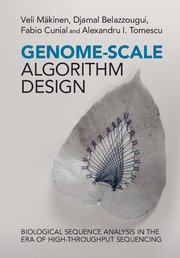Preface
Published online by Cambridge University Press: 05 May 2015
Summary
Background
High-throughput sequencing has recently revolutionized the field of biological sequence analysis, both by stimulating the development of fundamentally new data structures and algorithms, and by changing the routine workflow of biomedical labs. Most key analytical steps now exploit index structures based on the Burrows–Wheeler transform, which have been under active development in theoretical computer science for over ten years. The ability of these structures to scale to very large datasets quickly led to their widespread adoption by the bioinformatics community, and their flexibility continues to spur new applications in genomics, transcriptomics, and metagenomics. Despite their fast and still ongoing development, the key techniques behind these indexes are by now well understood, and they are ready to be taught in graduate-level computer science courses.
This book focuses on the rigorous description of the fundamental algorithms and data structures that power modern sequence analysis workflows, ranging from the foundations of biological sequence analysis (like alignments and hidden Markov models) and classical index structures (like k-mer indexes, suffix arrays, and suffix trees), to Burrows–Wheeler indexes and to a number of advanced omics applications built on such a basis. The topics and the computational problems are chosen to cover the actual steps of large-scale sequencing projects, including read alignment, variant calling, haplotyping, fragment assembly, alignment-free genome comparison, compression of genome collections and of read sets, transcript prediction, and analysis of metagenomic samples: see Figure 1 for a schematic summary of all the main steps and data structures covered in this book. Although strongly motivated by high-throughput sequencing, many of the algorithms and data structures described in this book are general, and can be applied to a number of other fields that require the processing of massive sets of sequences. Most of the book builds on a coherent, self-contained set of algorithmic techniques and tools, which are gradually introduced, developed, and refined from the basics to more advanced variations.
Information
- Type
- Chapter
- Information
- Genome-Scale Algorithm DesignBiological Sequence Analysis in the Era of High-Throughput Sequencing, pp. xvii - xxiiPublisher: Cambridge University PressPrint publication year: 2015
